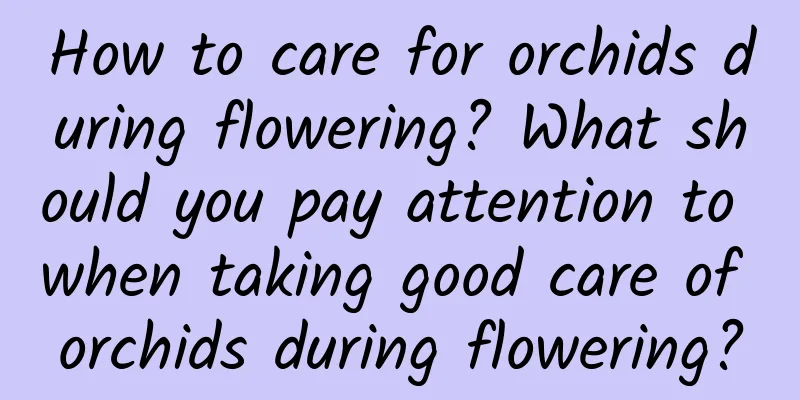How to care for orchids during flowering? What should you pay attention to when taking good care of orchids during flowering?

|
After the orchid buds appear, water it appropriately to keep the pot soil moist. Be careful not to have water in the buds. After the flowers bloom, reduce the amount of watering and water when the soil is dry and wet. Today we will specifically introduce the key points of orchid maintenance during the flowering period. WateringAfter the orchid grows flower buds, water it appropriately to keep the pot soil moist. If there is a lack of water, the flower stalk will rise, so water it when the soil is dry and when it is wet. When watering, be careful not to sprinkle water into the flower buds, otherwise it will easily cause the flower buds to rot. After the orchid blooms, water it less. Excessive watering will easily cause the outer three petals of the flower to elongate, affecting the beauty of the plant. Reasonable fertilizationIf the orchid is provided with sufficient nutrients before it buds, then there is no need to fertilize it again after the buds open. The nutrients already in the plant can prompt it to bloom. However, if the nutrients given at ordinary times are insufficient, it is necessary to add fertilizer appropriately after the flower buds grow. Potassium dihydrogen phosphate solution can be applied and the solution can be diluted before spraying. Reasonable fertilization can promote flowering and prolong the flowering period of orchids . Light adaptationOrchids are semi-shade plants . After the orchids grow flower buds, move the plants to a place with sufficient scattered light. Allowing orchids to have sufficient light will help them bloom more beautiful and colorful flowers. After the flower buds bloom, move the plants to a cool place and avoid direct sunlight, which will help prolong the flowering period. Timely bud thinningOrchids have a long flowering period. As the number of flower buds increases, the dead flowers and branches need to be cut off in time . This helps to ensure that the newly opened flowers have enough nutrients and the plants continue to bloom. Water and fertilizerOrchids consume more nutrients when they bloom, so be sure to fertilize them in time. Before the flower stalks grow out, you can give them some diluted cake fertilizer water every month . After flowering, use fertilizer once every half a month to make the flowers more beautiful. Pest and disease preventionBefore flowering, pay attention to reducing fertilization. Increasing the amount of fertilizer before flowering may increase the possibility of infection with pests and diseases. It is necessary to supplement fungicides in time to prevent infection and root rot of plants. Protect from rainAfter orchids have buds, they need to be protected from rain , as rain can easily cause petals to wither, which is not conducive to the growth of the plant. In windy and rainy weather, the plants must be moved indoors to avoid being exposed to rain. |
>>: How many days is the growing period of celery? How long does it take for celery to mature?
Recommend
Lina Lian's beheading reproduction
Soil preparation Linalina needs to be beheaded fo...
Where is eucalyptus suitable for planting and where is it planted most?
Eucalyptus planting area Generally speaking, euca...
Things to note when repotting Jade Plants, do you need to prune the roots when repotting Jade Plants?
1. Time to change pots Pay attention to the time ...
What fertilizer can make tea trees grow faster?
When fertilizing tea trees, you need to dig ferti...
Cultivation methods and precautions of succulent butt flowers
The succulent butt flower is relatively easy to g...
How to wrap the green radish if it is too long
1. Build a flower stand When the branches extend ...
How many years does hawthorn bear fruit?
Introduction to Hawthorn Planting Hawthorn prefer...
If you do this when the spring taro leaves turn yellow, they will turn green in minutes!
There are many reasons why the leaves of taro tur...
Flowers from the underworld suddenly appeared in Sichuan! A brief talk about the past and present of fairy grass!
Flower of the Underworld According to legend, the...
Advantages and Disadvantages of Zebra Patience Rose
Zebra Patience Rose is a cut rose variety origina...
Can yam be eaten after it sprouts? How to plant yam after it sprouts?
1. Can I eat it? Yam sprouts are also edible. The...
Is Datura poisonous?
1. Highly toxic It can be said that the entire bo...
How to breed azalea
1. Cutting propagation Cuttings are the simplest ...
Is potato a fruit or a vegetable?
Are potatoes a fruit or a vegetable? Potatoes are...
How to grow Caladium
1. Breeding environment 1. Soil: The main require...









